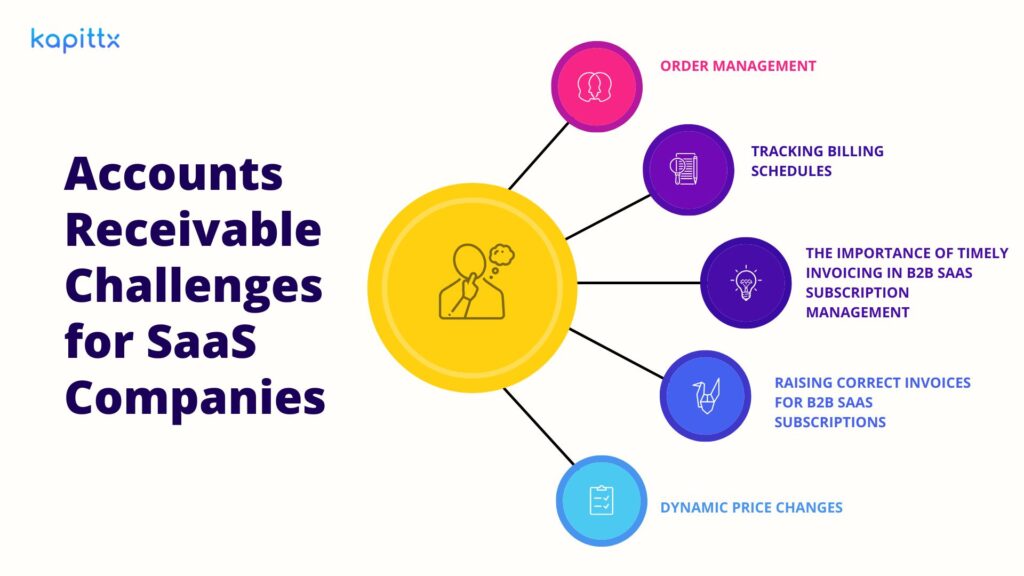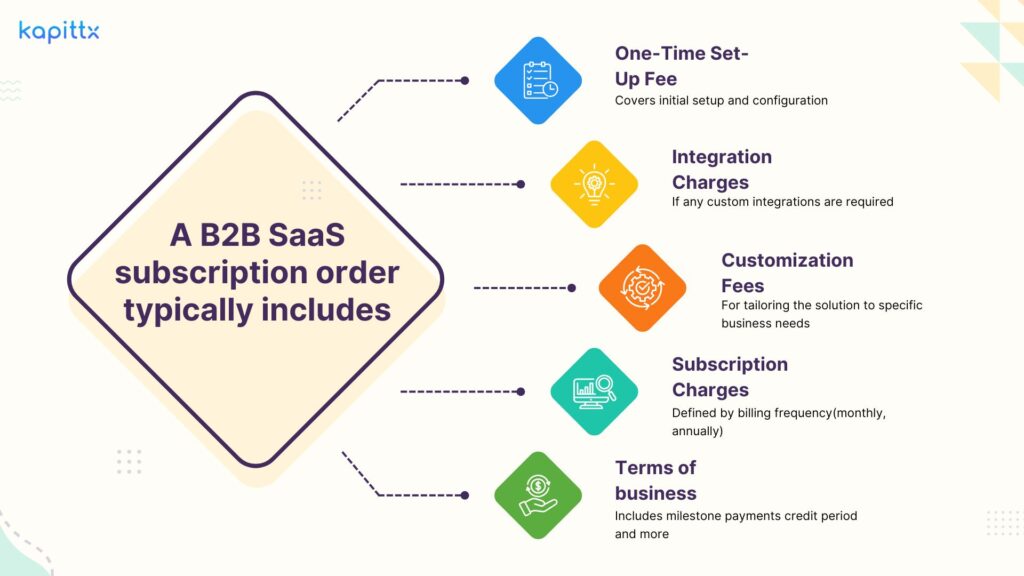Get the most out of NetSuite or Oracle Fusion with AI-Powered Accounts Receivable
May 16, 2024Accounts Receivable Automation with Microsoft Dynamics 365 To Improve Cash Flow and Drive Growth
June 26, 2024The global B2B SaaS market is projected to experience significant growth from 2024 to 2032. This expansion is driven by the rising demand for cloud-based software solutions that enhance business efficiency and cost-effectiveness.
The B2B SaaS industry offers a variety of solutions, including Customer Relationship Management (CRM), Human Resources (HR), Enterprise Resource Planning (ERP), and project management software. These tools are designed to automate and streamline business operations, foster collaboration, and boost productivity.
Based on the size of the target customers, broad-level go-to-market (GTM) segmentation for B2B SaaS subscription management includes:
- Small and Medium Enterprises (SMEs)
- Mid-Market
- Large Enterprises
For SaaS subscription payments, SMEs are typically willing to use credit cards to access B2B SaaS products. However, Mid-Market and Large Enterprises often prefer to operate on credit terms, which necessitates managing accounts receivable.
For SaaS subscription payments, SMEs are typically willing to use credit cards to access B2B SaaS products. However, Mid-Market and Large Enterprises often prefer to operate on credit terms, which necessitates managing accounts receivable.
Accounts Receivable Challenges for SaaS Companies
Running a B2B SaaS Subscription management business is incredibly challenging. In today’s hyper-competitive market, in your SaaS subscription business, you must manage multiple aspects such as onboarding, adoption, upselling, customer success, retention, and churn.
The last thing you want to worry about is accounts receivable management.
This is particularly true for enterprise SaaS companies, where users often do not provide credit card details for auto-debit transactions. Consequently, you are compelled to offer ‘invoice payment’ terms. This means, similar to traditional businesses, you invoice clients and typically collect payment 30 days later, hoping the customer pays on time.
Let us delve into some of the B2B SaaS subscription management challenges that could potential have a direct correlation with your SaaS subscription billing and payment.

1. Order Management
Enterprise customers typically issue a Purchase Order (PO) for any product or service, and B2B SaaS subscriptions are no exception. These POs capture deliverables and commercial terms that should be thoroughly examined before acceptance.
A B2B SaaS subscription order typically includes:

Payment terms may include milestone payments for integration and onboarding, the start of the go-live subscription, and usage-based rates. It’s important to note that customers rely on their internal documents for commercial and payment terms, not just your published plan.
As your business grows and the number of orders increases, tracking SaaS subscription milestone payments can become overwhelming and time-consuming. Implementing an order-to-cash and subscription management tool like Kapittx can significantly streamline this process and support your growth.
2. B2B SaaS Subscription Billing Challenges: Tracking Billing Schedules:
Managing B2B SaaS subscription billing schedules requires attention to detail, clear communication with customers, and the right tools. By leveraging subscription billing tracking solutions like Kapittx, companies can streamline their processes, reduce errors, and ensure timely payments.
A. Diverse Billing Plans:
B2B SaaS subscription companies offer various billing plans to accommodate different customer needs. These plans can include monthly, quarterly, bi-annually, or yearly billing cycles. Each billing plan has its own set of terms and conditions, affecting the frequency and timing of payments.
B. Go-Live Dates vs. Billing Dates:
Some SaaS companies tie billing dates to the go-live dates of their services. For example, if a customer’s software implementation goes live on the 15th of the month, their billing cycle might start from that date. However, other companies have a policy of billing for the entire month, regardless of the go-live date. This can lead to confusion and misalignment between service usage and billing periods.
C. Customer-Specific Billing Dates:
Different customers may have unique billing dates based on their contract terms or historical preferences. Managing multiple billing schedules simultaneously can become complex, especially when dealing with a large customer base.
D. Subscription Billing Tracking Tools:
Implementing a robust subscription billing tracking tool can streamline the entire process. Such tools can:
- Centralize Billing Information: Store billing details for each customer, including billing frequency, due dates, and payment history.
- Automate Reminders: Send automated reminders to customers before their payment due dates.
- Generate Invoices: Create accurate invoices based on the billing plan and customer-specific terms.
- Handle Prorated Charges: Manage mid-cycle changes (e.g., upgrades, downgrades) and calculate prorated charges accordingly.
3. The Importance of Timely Invoicing in B2B SaaS Subscription management:
Timely invoicing not only ensures smoother financial operations but also fosters positive relationships with your customers. Enterprises follow specific payment processing cycles, often with a credit period that extends a certain number of days after the invoice date. If you issue the invoice late, it directly impacts the payment processing timeline. Late invoices lead to delayed payments.
For SaaS subscription companies, maintaining healthy cash flow is essential. Timely payments from customers contribute significantly to this. Late payments can disrupt financial planning, hinder growth, and strain operational resources.
Avoiding Payment Delays – When you bill on time, you increase the chances of receiving payments promptly. Late invoices may result in delayed approvals, additional processing time, and potential disputes.
Monthly billing cycles can be particularly tricky. Missing a billing cycle means you might end up submitting two months’ worth of invoices simultaneously. This situation can confuse customers and create administrative challenges.
With Kapittx a b2b SaaS subscription management proactively monitor SaaS subscription billing due dates closely. You can maintain a billing calendar that tracks all customer invoices that Include billing dates, due dates, and follow-up actions.
4. Raising Correct Invoices for B2B SaaS Subscriptions
Accurate and transparent invoicing contributes to a smoother billing process and fosters positive relationships with your customers.
Many SaaS subscription plans are based on usage metrics. These metrics could include the number of users, data consumed, or other measurable factors. For example, a company might pay based on the number of active users or the volume of data processed through the SaaS platform.
Differential user rates add complexity to billing. Some users may be on a basic plan, while others might have access to premium features. Managing these variations accurately is crucial to avoid disputes and ensure fair billing.
Transparency about user counts and consumption is vital. Customers should easily verify the details on their platform. Providing clear usage reports or dashboards helps build trust and minimizes billing discrepancies. When generating invoices, ensure that they reflect the actual usage and user rates.
Consequences of Ineffective arm accounts receivable management leading to accounts receivable challenges can be due to an inadequate AR process which can trigger a cascade of issues:
5. Dynamic price changes
Enterprise SaaS subscription plans may have a base plan for X users and a pre-agreed rate for additional users. Further some deals which are long-term could have pre-agreed price escalation clauses. All these complexities need a sophisticated SaaS Subscription Management system.
Challenges in SaaS Subscription Receivables Management
- High Days Sales Outstanding (DSO):
- DSO measures the average number of days it takes to collect payment from customers after a sale. Slow payment from customers can strain a company’s cash flow and profitability.
- Management Time and Efficiency:
- Managing accounts receivable can be time-consuming, especially when processes are inefficient or manual.
- Delays in Invoice Submission:
- Timely invoice submission is essential for prompt payment. Identifying bottlenecks that impact invoice submission is critical.
Streamlining SaaS Subscription Payments with Kapittx
Kapittx offers innovative solutions to address these challenges:
- Automation: Kapittx replaces manual processes with automation, reducing the time spent on routine tasks. It streamlines invoice submission, payment reconciliation, and alerts.
- Integration: By integrating Kapittx with your ERP Billing platform, you create a seamless flow of information. Alerts for delays, risks, and other critical events are delivered in real time.
- Complete Control: Kapittx provides end-to-end visibility into the invoice-to-cash lifecycle. You gain control over receivables, ensuring timely collections and minimizing financial risks2.
In summary, Kapittx not only helps manage SaaS subscriptions efficiently but also empowers you with better control over your accounts receivable processes. Feel free to explore Kapittx further to optimize your financial stability
Click here to see a case study from Kapittx.
Check out Kapittx’s LinkedIn here.
